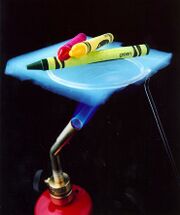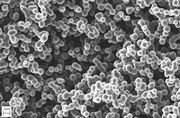Difference between revisions of "Aerogel, silica"
| (4 intermediate revisions by the same user not shown) | |||
| Line 1: | Line 1: | ||
| − | [[File:Aerogel Supedium.jpg|thumb|Silica | + | [[File:Aerogel Supedium.jpg|thumb|Silica aerogel<br> Supedium [https://supedium.com/our-universe-space/the-incredible-aerogel/ Incredible Aerogel]]] |
| + | [[File:Aerogelcrayons NASA.jpg|thumb|Crayons on aerogel over flame<br>NASA: [https://solarsystem.nasa.gov/stardust/tech/aerogel.html Aerogel]]] | ||
| + | [[File:Aerogel structure.jpg|thumb|Aerogel Structure (Silica)<br>[https://www.dlr.de/mp/en/desktopdefault.aspx/tabid-4961/11054_read-25264/ Institute of Material Physics in Space]]] | ||
==Description== | ==Description== | ||
| − | + | A synthetic, open-celled solid foam that is composed of a network of interconnected nanostructures of silica. Aerogels are derived from gels in which the liquid has been replaced with gas while retaining the structure of the solid framework. The first document example of an aerogel was created the Samuel Kistler in 1931 with a silica gel (patented 1937). The unique properties of aerogels are due to its high surface area and open porous structure that provides extremely low density, thermal conductivity, and sound conductivity. Although they may feel fragile to the touch, they have strong structural integrity. They have been used in solar cells, fuel cells, batteries, supercapacitors as well as more mundane things, such as paints, cosmetics, coats, rugs, pipes, spill-clean-up kits and insulation. Of particular interest for museums is its usefulness in fire protection blankets (Praestegaard 2023). | |
| + | |||
== Synonyms and Related Terms == | == Synonyms and Related Terms == | ||
| + | aerogel; air glass; frozen smoke; blue smoke; solid air; solid cloud | ||
| + | |||
| + | Brand names: Santocel (obsolete); [[Pyrogel]]; Nanogel; Cryogel; Spaceloft; AeroZero | ||
==Applications== | ==Applications== | ||
| Line 12: | Line 18: | ||
==Physical and Chemical Properties== | ==Physical and Chemical Properties== | ||
* Can withstand temperatures up to 1200C | * Can withstand temperatures up to 1200C | ||
| − | * Very lightweight | + | * Very lightweight |
| − | |||
| − | |||
| − | |||
| − | |||
| − | |||
==Resources and Citations== | ==Resources and Citations== | ||
| − | * Praestegaard L., G. Sorig Thomsen, K. Woer 'Before the Fire: Experiments on Fire-Protecting Cover Materials', Studies in Conservation, | + | * Praestegaard L., G. Sorig Thomsen, K. Woer 'Before the Fire: Experiments on Fire-Protecting Cover Materials', Studies in Conservation, 68(1), 1-8, (2023) [https://doi.org/10.1080/00393630.2021.1978227 link] |
* Alwin, S., Sahaya Shajan, X. Aerogels: promising nanostructured materials for energy conversion and storage applications. Mater Renew Sustain Energy 9, 7 (2020). | * Alwin, S., Sahaya Shajan, X. Aerogels: promising nanostructured materials for energy conversion and storage applications. Mater Renew Sustain Energy 9, 7 (2020). | ||
* Skanacid A/S: www.skanacid.dk | * Skanacid A/S: www.skanacid.dk | ||
Latest revision as of 10:44, 8 July 2023
Description
A synthetic, open-celled solid foam that is composed of a network of interconnected nanostructures of silica. Aerogels are derived from gels in which the liquid has been replaced with gas while retaining the structure of the solid framework. The first document example of an aerogel was created the Samuel Kistler in 1931 with a silica gel (patented 1937). The unique properties of aerogels are due to its high surface area and open porous structure that provides extremely low density, thermal conductivity, and sound conductivity. Although they may feel fragile to the touch, they have strong structural integrity. They have been used in solar cells, fuel cells, batteries, supercapacitors as well as more mundane things, such as paints, cosmetics, coats, rugs, pipes, spill-clean-up kits and insulation. Of particular interest for museums is its usefulness in fire protection blankets (Praestegaard 2023).
Synonyms and Related Terms
aerogel; air glass; frozen smoke; blue smoke; solid air; solid cloud
Brand names: Santocel (obsolete); Pyrogel; Nanogel; Cryogel; Spaceloft; AeroZero
Applications
- Fire protection
- Thermal and sound insulation
- Thickener
Risks
Physical and Chemical Properties
- Can withstand temperatures up to 1200C
- Very lightweight
Resources and Citations
- Praestegaard L., G. Sorig Thomsen, K. Woer 'Before the Fire: Experiments on Fire-Protecting Cover Materials', Studies in Conservation, 68(1), 1-8, (2023) link
- Alwin, S., Sahaya Shajan, X. Aerogels: promising nanostructured materials for energy conversion and storage applications. Mater Renew Sustain Energy 9, 7 (2020).
- Skanacid A/S: www.skanacid.dk
- Supedium: The Incredible Aerogel
- Wikipedia: https://en.wikipedia.org/wiki/Aerogel
- Aerogel: What is Aeogel?


